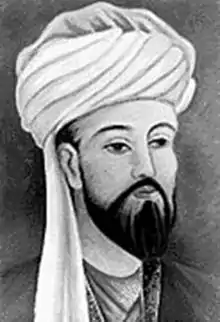Rashid ad-Din Sinan
Rashid al-Din Sinan (Arabic: رشيد الدين سنان Rashīd ad-Dīn Sinān), also known as the Old Man of the Mountain (Arabic: شيخ الجبل Shaykh al-Jabal, Latin: Vetulus de Montanis),[1][2] was a da'i (missionary)[3] and a leader of the Syrian branch of the Nizari Isma'ili state (the Assassins), and a figure in the history of the Crusades.[4]
Rashid ad-Din Sinan | |
|---|---|
رشيد الدين سنان | |
 Engraving of Rashid ad-Din Sinan. | |
| Personal | |
| Born | Abu al-Hasan Sinan ibn Sulayman ibn Muhammad 1131 or 1135 |
| Died | 1193 (age 58 or 61) |
| Resting place | Salamiyah, Syria |
| Religion | Nizari Ismaili Shia Islam |
| Nationality | Nizari Ismaili state |
| Education | Persia Madrasa of Hasan ibn Muhammad ibn Ali, Alamut |
| Known for | Leader of the Syrian Nizari Ismailis, figure in the Third Crusade |
| Other names | Old Man of the Mountain |
| Military service | |
| Rank | Da'i of Basra District (~1160–1163) Chief Da'i of Syria (since ~1163) |
| Senior posting | |
| Predecessor | Abu Muhammad |
| Successor | Abu Mansur ibn Muhammad or Nasr al-'Ajami |
| Part of a series on Shīa Islam
Isma'ilism |
|---|
 |
|
|
Biography
Rashid ad-Din Sinan was born between the years 1132 and 1135 in Basra, southern Iraq, to a prosperous family.[5] According to his autobiography, of which only fragments survive, Rashid came to Alamut, the centre of the Assassins, as a youth after an argument with his brothers,[5] and received the typical Assassin training. In 1162, the sect's leader Ḥassan ʿAlā Dhikrihi's Salām sent him to Syria, where he proclaimed Qiyamah (repeating the ceremony of Hassan II at Alamut), which in Nizari terminology meant the time of the Qa'im and the removal of Islamic law. Based at the Nizari strongholds al-Kahf and later Masyaf, he controlled the northern Syrian districts of Jabal as-Summaq, Maarrat Misrin and Sarmin.[6]
Rashid enjoyed considerable independence from the Nizari centre in Alamut and some writings attribute him with a semi-divine status usually given to the Nizari Ismaili Imam.
His chief enemy, the Sultan Saladin (1137/1138–1193), ruled over Egypt and Syria from 1174 to 1193. Saladin managed twice to elude assassination attempts ordered by Rashid and as he was marching against Aleppo, Saladin devastated the Nizari possessions. In 1176 Saladin laid siege to Masyaf but he lifted the siege after two notable events that reputedly transpired between him and the Old Man of the Mountain. According to one version, one night, Saladin's guards noticed a spark glowing down the hill of Masyaf and then vanishing among the Ayyubid tents. Saladin awoke from his sleep to find a figure leaving the tent. He saw that the lamps in his tent were displaced and beside his bed laid hot scones of the shape peculiar to the Assassins with a note at the top pinned by a poisoned dagger. The note threatened that he would be killed if he did not withdraw from his siege. Saladin gave a loud cry, exclaiming that Sinan himself was the figure that left the tent. As such, Saladin told his guards to come to an agreement with Sinan. Realizing he was unable to subdue the Assassins, he sought to align himself with them, consequently depriving the Crusaders of aligning themselves against him.
Sinan's last notable act occurred in 1191, when he ordered the successful assassination of the newly elected King of Jerusalem Conrad of Montferrat. Whether this happened in coordination with King Richard I of England or with Saladin, or with neither, remains unknown.
In 1193, Sinan wrote a letter to Leopold V, Duke of Austria at the request of Richard I, taking credit for the assassination order and subsequent death of Conrad of Monferrat, of which Richard was being accused.[7] However, this letter is believed by modern historians to be a forgery written after Sinan's death.[8]
He died in 1193 in al-Kahf Castle in Masyaf, Syria and buried in Salamiyah.[9] He was succeeded in 1192 or 1193 by the Persian da'i Abu Mansur ibn Muhammad or Nasr al-'Ajami appointed from Alamut, which regained a closer supervision over Syrian assassins.[10]
Popular culture
Rashid ad-Din Sinan appears as a character in Assassin's Creed under the nickname Al Mualim.[11] In the videogame, Al Mualim ordered Altaïr to kill Robert IV de Sable in 1191 at the battle of Arsuf.[12]
References
- Mentioned in Latin sources from the Crusader states.
- Mirza, Dr. Naseeh Ahmed. "Alamut. Bastion of Peace and Information". Alamut. Melbourne, Australia. Retrieved February 8, 2018.
- "Rashid al-Din Sinan". Oxford Reference. 2003. Retrieved February 8, 2018.
- Reston Jr. 2001, p. 16.
- Wasserman 2001, p. 119.
- "" راشد الدین سنان " پیشوای بزرگ اسماعیلیان شام در عصر صلیبی". www.hawzah.net. Retrieved 2017-08-20.
- Reston Jr. 2001, p. 372.
- Letters from the East : Crusaders, Pilgrims and Settlers in the 12th-13th centuries. Barber, Malcolm., Bate, Keith. Farnham, Surrey: Ashgate. 2013. p. 92. ISBN 978-1-4724-1395-6. OCLC 846946318.CS1 maint: others (link)
- Willey, Peter (November 25, 2005). Eagle's Nest: Ismaili Castles in Iran and Syria. Institute of Ismaili Studies. I.B.Tauris. p. 234. ISBN 978-1-85043-464-1.
- Daftary, Farhad (2007). The Isma'ilis: Their History and Doctrines. Cambridge University Press. p. 389. ISBN 9781139465786.
- Nichols, Derek (September 27, 2013). "History Behind the Game – Assassin's Creed Characters". VentureBeat. Retrieved February 8, 2018.
- Delrio, Francesco (31 January 2018). "Assassin's Creed: Mito, Storia e Videogioco (Prima Parte)". Every Eye (in Italian). Retrieved 28 April 2018.
Bibliography
- Daftary, Farhad (2014). "RĀŠED-AL-DIN SENĀN". Encyclopaedia Iranica.
- Halm, Heinz, Die Schia, Darmstadt 1988, pp. 228f.
- Runciman, Steven: A history of the Crusades Volume 2: The kingdom of Jerusalem and the Frankish East pp. 410
- Franzius, Enno (1969). History of the Order of Assassins. New York: Funk & Wagnalls. p. 261.
- Hodgson, Marshall G. S. (1955). The Order of the Assassins: The Struggle of theEarly Nizari Isma'ilis against the Islamic World. The Hague, Netherlands: Mouton. p. 352. ISBN 9780404170189.
- Lewis, Bernard (1968). The Assassins: A Radical Sect in Islam. New York: Basic Books. p. 166. ISBN 9780465004980. OCLC 1740057.
- Mirza, Nasseh Ahmed (1997). Syrian Ismailism: The Ever Living Line of theImamite, AD 1100–1260. Richmond, UK: Curzon.
- Reston Jr., James (2001). Warriors of God: Richard the Lionheart and Saladin in the Third Crusade. New York: Doubleday. ISBN 9780385495615.
- Wasserman, James (April 1, 2001). The Templars and the Assassins: The Militia of Heaven. Simon and Schuster. p. 320. ISBN 9781594778735.
- "Rashid al-Din Sinan". www.alamut.com.